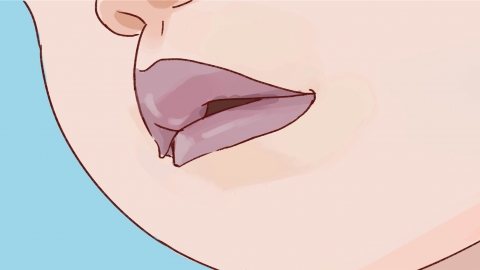What causes purple lips?
Cyanosis of the lips may be caused by cold exposure, excessive fatigue, anemia, chronic obstructive pulmonary disease (COPD), or congenital heart disease. Appropriate management can be selected based on specific circumstances. If bodily discomfort occurs, it is recommended to seek medical attention at a hospital promptly and follow medical advice for treatment.

1. Cold exposure: In cold environments, the body maintains core body temperature by constricting peripheral blood vessels, thereby reducing blood supply to the lips and causing them to turn purple. At this time, it is important to add clothing promptly, move to a warm environment, and drink warm water to promote blood circulation. Lip color typically returns to normal after some time.
2. Excessive fatigue: Prolonged overexertion may lead to accumulation of metabolic waste products and impaired blood circulation, affecting blood perfusion to the lips and causing them to appear purple. It is important to adjust one's schedule, ensure sufficient sleep (aiming for 7-8 hours per night), plan work and rest periods appropriately, and engage in relaxation activities such as deep breathing or meditation to relieve physical fatigue and improve the condition of purple lips.
3. Anemia: Deficiency of nutrients such as iron and vitamin B12, or blood loss, may lead to anemia, resulting in reduced hemoglobin levels and decreased oxygen-carrying capacity of blood. This may cause cyanosis of the lips, as well as pallor and fatigue. Follow medical advice to use medications such as ferrous sulfate tablets, vitamin B12 tablets, and folic acid tablets to improve anemia symptoms.
4. Chronic obstructive pulmonary disease: Often caused by long-term smoking or air pollution, COPD may lead to impaired ventilation and gas exchange in the lungs, resulting in insufficient oxygen intake, cyanosis of the lips, and symptoms such as coughing, sputum production, and difficulty breathing. It is recommended to use medications such as salbutamol aerosol, ipratropium bromide aerosol, and aminophylline tablets under medical guidance to improve pulmonary ventilation function.
5. Congenital heart disease: Abnormal development of heart structure may cause mixing of arterial and venous blood within the heart, leading to reduced oxygen content in the blood and bluish-purple lips. Patients may also experience reduced exercise tolerance and shortness of breath. Patients may use medications such as digoxin tablets, hydrochlorothiazide tablets, and spironolactone tablets under medical guidance to improve cardiac function and alleviate symptoms.
In daily life, it is recommended to dress appropriately according to temperature changes, adjust clothing as needed, and avoid prolonged exposure to cold outdoor environments.
References:
[1] Zhu HX, Zhao MZ, Zhang HB, et al. Exploring the mechanism of Houttuynia cordata in treating chronic obstructive pulmonary disease based on network pharmacology and molecular docking. Hebei Medical Journal, 2025, 31(01):72-77.
[2] Does purple lips indicate heart problems? Family Medicine. Joyful Health Management, 2017, (12):86.






